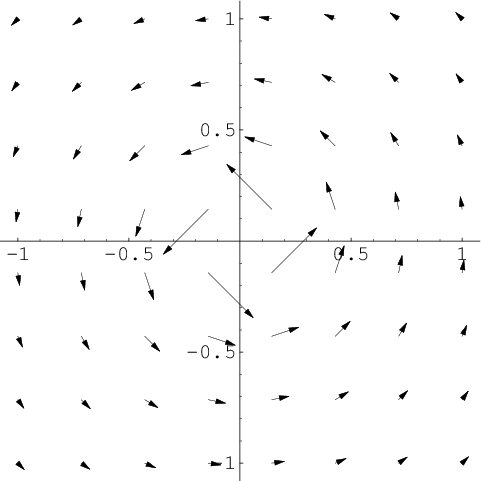A path-dependent vector field with zero curl
Our goal is to determine if the vector field F(x,y)=(−yx2+y2,xx2+y2)
One condition for path independence is the following. For a simply connected domain, a continuously differentiable vector field F is path-independent if and only if its curl is zero.
Since F(x,y) is two dimensional, we need to check the scalar curl ∂F2∂x−∂F1∂y.
Can we conclude F is conservative? The problem is that F is not defined at the origin (0,0). Its domain of definition has a hole in it, which for two-dimensional regions, is enough to prevent it from being simply connected. The test does not apply, and we still don't know whether or not F is conservative.
Let's try another test, this time a test for path-dependence. If we can find a closed curve along which the integral of F is nonzero, then we can conclude that F is path-dependent. If the curve does not go around the origin, then we can use Green's theorem to show the integral of F zero, ∫BF⋅ds=∫D(∂F2∂x−∂F1∂y)dA=∫D0dA=0,
We must try a closed curve where Green's theorem does not apply, i.e., one that goes around the point at the origin where F is not defined. We'll use the unit circle.
A counterclockwise parametrization of the unit circle is c(t)=(cost,sint) for 0≤t≤2π. On the unit circle, F takes a simple form, F(c(t))=F(cost,sint)=(−sintcos2t+sin2t,costcos2t+sin2t)=(−sint,cost).
The hole in the domain at the origin did end up causing trouble. We found a curve C where the circulation around C is not zero. The vector field F is path-dependent.
This vector field is the two-dimensional analogue of one we used to illustrate the subtleties of curl, as it had curl-free macroscopic circulation. The circulation can be clearly seen by plotting the vector field F. It's difficult to plot, because the vector field blows up at the origin.
Further insight into F can be obtained from the fact that F has a potential function if, for example, you restrict yourself to the right half-plane with x>0. In this case, you can write F(x,y)=∇f(x,y), where f(x,y)=arctan(y/x). Of course, this potential function cannot be extended to the whole plane, or we'd run into a contradiction with the fact that ∫CF⋅ds≠0 when C is the unit circle. Besides not being defined along the line x=0, it is also discontinuous across that line. But, the existence of this potential function explains why the curl should be zero away from the line x=0. (The whole line x=0 isn't special for F, as the origin is the only point that causes problems. You could, for example, use f(x,y)=−arctan(x/y) for a potential function away from the line y=0.)
Thread navigation
Multivariable calculus
- Previous: A conservative vector field has no circulation
- Next: Testing if three-dimensional vector fields are conservative
Math 2374
Notation systems
Similar pages
- A conservative vector field has no circulation
- Subtleties about curl
- The idea behind Green's theorem
- Calculating the formula for circulation per unit area
- The gradient theorem for line integrals
- How to determine if a vector field is conservative
- Finding a potential function for conservative vector fields
- Finding a potential function for three-dimensional conservative vector fields
- A simple example of using the gradient theorem
- Testing if three-dimensional vector fields are conservative
- More similar pages
